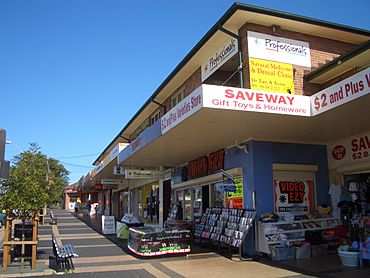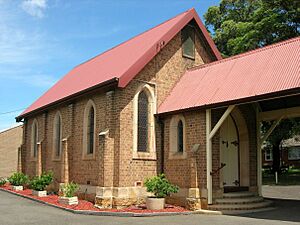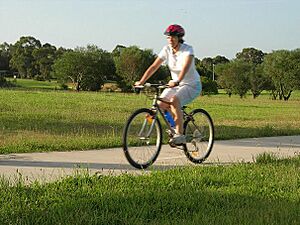Ermington, New South Wales facts for kids
Quick facts for kids ErmingtonSydney, New South Wales |
|||||||||||||||
|---|---|---|---|---|---|---|---|---|---|---|---|---|---|---|---|

Ermington shops on Betty Cuthbert Avenue
|
|||||||||||||||
| Population | 10,737 (2016 census) | ||||||||||||||
| • Density | 2,386/km2 (6,180/sq mi) | ||||||||||||||
| Postcode(s) | 2115 | ||||||||||||||
| Elevation | 36 m (118 ft) | ||||||||||||||
| Area | 4.5 km2 (1.7 sq mi) | ||||||||||||||
| Location | 19 km (12 mi) north-west of Sydney CBD | ||||||||||||||
| LGA(s) | City of Parramatta | ||||||||||||||
| State electorate(s) | Parramatta | ||||||||||||||
| Federal Division(s) | |||||||||||||||
|
|||||||||||||||
Ermington is a suburb of Sydney, New South Wales, Australia. It is located about 19 kilometres west of the main city centre of Sydney. Ermington is part of the City of Parramatta area and sits on the northern side of the Parramatta River.
Contents
History
First People of the Land
The land where Ermington is today was originally home to the Wallumettagal/Wallumedegal people. Some records also suggest that the Wongal/Wangal people lived here. These Aboriginal groups were the first custodians of this land.
European Settlement Begins
Ermington was once part of a large area called the Field of Mars. In 1792, Governor Arthur Phillip gave pieces of land along the Parramatta River to eight marines. Each marine received about 80 acres (which is about 32 hectares) of land. They used this land to grow crops like wheat, corn, and vegetables.
One of these marines, Alexander McDonald, owned land that stretched from the Parramatta River up to what is now Stevens Street. His old house is still standing today at 15-17 Honor Street. He grew wheat and sold it to bakers in Sydney.
Another marine, John Colthread, also received 80 acres of land. Later, in 1827, a police officer named Major Edmund Lockyer bought this land. He built a stone house called Ermington. He named it after a place in England where his second wife was born. The house was finished in 1828 and was near where the Ryde-Parramatta Golf Course is now.
Farming and Orchards
Ermington played an important part in Australia's early wine industry. In 1806, Gregory Blaxland started a vineyard here and made wines that won awards. In 1822, Australia's first wine export to England came from Blaxland's 'Brush Farm' vineyard in Ermington.
From the 1830s, Ermington became famous for its fruit, especially oranges, lemons, apples, and apricots. Farmers would take their produce down to Pennant Hills Wharf. From there, small boats would carry the fruit to markets in Sydney.
Growth of Homes and Factories
In the 1930s, some low-lying areas near the Parramatta River were filled in to prepare for new houses. However, these plans were put on hold because of the Great Depression, a time when many people lost their jobs and money.
During World War II, in 1943, the area became the Ermington Naval Storage Depot. Seven large warehouses were built here to store supplies for the United States Army. After the war, the Royal Australian Navy used the site for storage.
After 1945, the Australian government bought many of the fruit farms in Ermington. They divided the land into smaller blocks and built hundreds of homes for soldiers returning from the war and their families. You can still see many of these older homes today.
In the 1970s, a large area that is now George Kendall Riverside Park was used as a landfill site for rubbish. Later, it was cleaned up and new plants were grown there.
Since the early 2000s, many young families have moved to Ermington because houses were more affordable. Also, the nearby city of Parramatta has been growing, attracting more workers. In 2006-2007, the old Naval Storage Depot site was cleared. A company called Stockland then built the Riverwalk estate, which has modern houses right by the Parramatta River.
Shopping Area
The Ermington Shopping Centre opened in 1958. It was very important for the many families who moved into the new homes built after the war. Today, the shops along Betty Cuthbert Avenue are still a busy place for locals to buy things.
Important Places
Army Barracks
Timor Barracks is an army base located on the northern edge of Ermington. It is currently home to the 8th Command Support Regiment. In the past, it had a very tall antenna tower for army communications, but this was taken down years ago.
The barracks opened in 1968. It was built on the site of the old transmitter for the 2CH radio station. The area around the transmitter used to be a market garden owned by a company called Yates.
The Lottie Stewart Hospital
Next to the Timor Barracks is the Lottie Stewart Hospital. This hospital helps people who are very sick and need special care (this is called palliative care). It is run by the Wesley Mission and opened in 1948. Every year, the Lottie Stewart Fete is a popular event in Ermington.
Subiaco Creek
Subiaco Creek starts in Ermington, collecting rainwater from the area around Timor Barracks and Lottie Stewart Hospital. Much of the creek now flows underground in pipes, but it does come to the surface again near Stevens Street and Spurway Street.
Getting Around
Victoria Road is a main road that connects Parramatta to the Anzac Bridge in Sydney. It runs through Ermington. Silverwater Road is another important road that crosses the Parramatta River over Silverwater Bridge.
Several Busways bus routes serve Ermington. For example, the 501 bus goes between Parramatta station and Railway Square in Sydney. Other buses connect Ermington to places like West Ryde, Melrose Park, and Westfield Burwood.
There are also plans for a new train line called the Parramatta Light Rail. Stage 2 of this project will pass through Ermington, connecting Westmead to Sydney Olympic Park.
In 2011, most people in Ermington (66%) drove to work, while only 16% used public transport like buses or trains.
Schools
- Ermington West Public School
- Rydalmere East Public School
- Melrose Park Public School
- Ermington Public School (which is actually located just outside Ermington in West Ryde)
Churches
The first church in Ermington was St Mark's Anglican Church, which opened in 1883. The first Catholic mass in the area was held in 1855, in a barn that had been changed into a church.
Parks
Ermington has several parks where people can relax and play:
- George Kendall Riverside Park
- Eccles Park
- Cowells Lane Reserve
- Thomas Wemyss Park
- Millers Reserve
- Hilder Reserve
- Tristram Reserve
- Lockyer Reserve
Sports and Fun
The Ermington United Sports & Recreation Club started in 1957. It is mainly based at George Kendall Riverside Park. Over the years, the club has been involved in many sports like Cricket, AFL (Australian Rules Football), archery, and boomerang throwing. Today, they focus on Soccer, Netball, and Tennis.
The 1st Ermington Scouts group was founded in 1953, offering fun activities for young people.
The Tigers Baseball & Softball Club plays its home baseball games at George Kendall Riverside Park. There are five baseball fields near the river used for T-Ball, junior, and senior games.
George Kendall Riverside Park also has playgrounds, covered seating areas for picnics, and a bike track for everyone to enjoy.
Population
Who Lives in Ermington?
At the 2016 census, there were 10,737 people living in Ermington.
- Where people are from: About 58% of people were born in Australia. Other common birthplaces included China (7%), South Korea (4%), and Lebanon (2.5%).
- Languages spoken: About 54% of people spoke only English at home. Other languages spoken included Mandarin (7.1%), Arabic (5.8%), and Korean (5.2%).
- Age: The average age of people in Ermington was 37 years old. About 20% of the population were children under 15.
- Homes: Most homes (68%) were stand-alone houses. About 39.5% of houses were rented.
Famous People from Ermington
- Betty Cuthbert: A famous Australian Olympic athlete who grew up in Ermington and went to Ermington Public School. The main street of the shopping centre, Betty Cuthbert Avenue, is named after her.
- Greg Matthews: A well-known Australian cricketer who also went to Ermington Public School.
- Alexander McDonald: One of the first marines to receive land in Ermington back in 1792.
Images for kids







